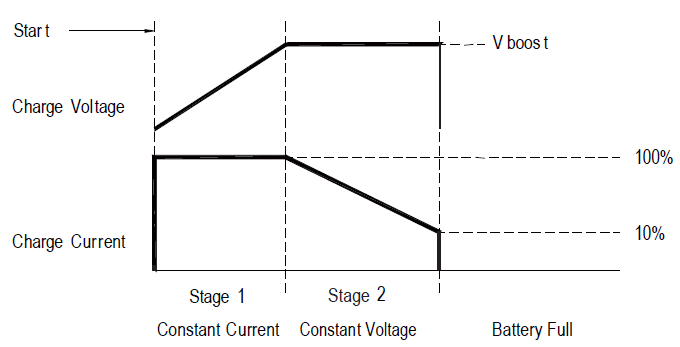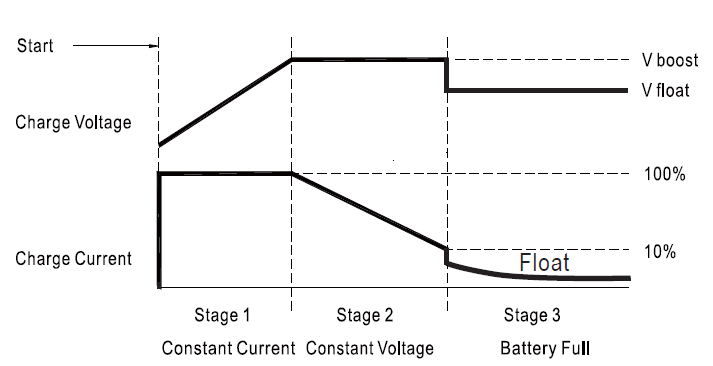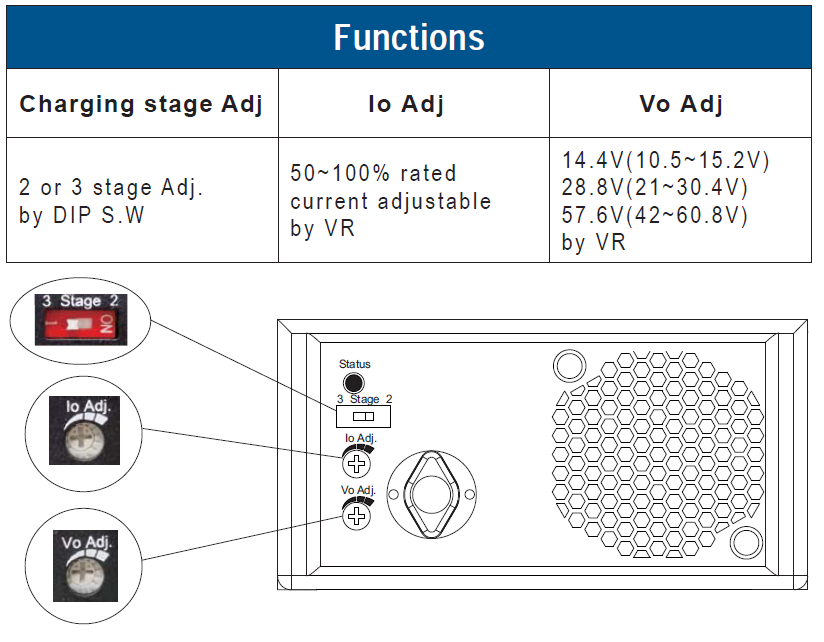Рекомендации от MEAN WELL по использованию зарядных устройств
Время от времени поступает вопрос – можно ли использовать вместо зарядного устройства какой-нибудь обычный импульсный AC/DC преобразователь. Прямого запрета на такое использование нет, но, тем не менее, рекомендация производителя однозначна – для заряда аккумуляторных батарей надо использовать только зарядные устройства. Для оптимального выбора зарядного устройства важно понимать как физические принципы процесса заряда аккумуляторных батарей, так и некоторые особенности зарядных устройств, которые упрощают процесс заряда и делают его безопасным.
Любое зарядное устройство работает в двух базовых режимах, которые проще всего проиллюстрировать на примере зарядной кривой из двух стадий (ЗУ серий PB-600, PB-1000):
 Кривая заряда из двух стадий
Кривая заряда из двух стадий
В первой стадии зарядное устройство работает в режиме стабилизации по току (Constant Current), по мере увеличения напряжения на заряжаемой батарее до установленного (или максимального для ЗУ) уровня происходит переход режима работы зарядного устройства в режим стабилизации по напряжению (Constant Voltage), то есть во вторую стадию. Почему не стоит использовать импульсные преобразователи для заряда – в подавляющем большинстве это устройства со стабилизацией по напряжению, режим стабилизации тока в них реализован только в качестве защитного режима (Overload Protection). И при существенном снижении сопротивления нагрузки импульсный преобразователь выключается (или переходит в прерывистый режим, hiccup mode). Иными словами, попытка зарядить обычным импульсным AC/DC преобразователем сильно разряженный аккумулятор может закончиться, даже не начавшись.
Какие особенности зарядных устройств от компании MEAN WELL упрощают процесс заряда?
- Наличие кривых заряда из двух, трех и восьми стадий. Помимо рассмотренной выше кривой из двух стадий, наиболее часто встречаемой и используемой является кривая заряда из трех стадий:
 Кривая заряда из трех стадий
Наличие третьей стадии позволяет использовать аккумулятор в буферном режиме, например, для систем бесперебойного или резервного питания. В этом случае зарядное устройство постоянно или достаточно продолжительное время подключено к АКБ и поддерживает уровень ее заряда на максимальном значении. Такой режим позволяет улучшить свойства свинцово-кислотной батареи (провести ее частичное восстановление), а также проводить ее автоматический подзаряд при нерегулярном и эпизодическом использовании АКБ.
Кривая заряда из трех стадий
Наличие третьей стадии позволяет использовать аккумулятор в буферном режиме, например, для систем бесперебойного или резервного питания. В этом случае зарядное устройство постоянно или достаточно продолжительное время подключено к АКБ и поддерживает уровень ее заряда на максимальном значении. Такой режим позволяет улучшить свойства свинцово-кислотной батареи (провести ее частичное восстановление), а также проводить ее автоматический подзаряд при нерегулярном и эпизодическом использовании АКБ.
- Выходные напряжения зарядных устройств от MEAN WELL оптимизированы под наиболее популярные типы аккумуляторных батарей (в том числе гелевые, AGM, Li-ion) с номинальным напряжениями 12, 24, 48В.
- Возможна установка уровня максимального выходного тока зарядного устройства и уровня напряжения заряда. На примере новых зарядных устройств серий NPB-120, NPB-240, NPB-360:
 Выбор стадий заряда и регулировка выходных параметров
Задание уровня выходного напряжения для простых зарядных устройств позволяет отрегулировать ЗУ для использования совместно с большинством типов свинцово-кислотных АКБ по рекомендациям производителей батарей. А задание уровня максимального выходного тока – существенно расширить диапазон заряжаемых батарей по их емкости.
Выбор стадий заряда и регулировка выходных параметров
Задание уровня выходного напряжения для простых зарядных устройств позволяет отрегулировать ЗУ для использования совместно с большинством типов свинцово-кислотных АКБ по рекомендациям производителей батарей. А задание уровня максимального выходного тока – существенно расширить диапазон заряжаемых батарей по их емкости.
- Дополнительные средства защиты и контроля состояния заряжаемых аккумуляторных батарей – защита от обратной полярности при ошибке подключения АКБ, защита от короткого замыкания (неисправность или глубокий разряд АКБ), защита от перенапряжения и защита от перегрева. Все эти защиты оптимизированы именно для работы зарядных устройств, и позволяют сделать процесс заряда батарей максимально безопасным.
Заключительная рекомендация направлена на безопасность процесса заряда – важно помнить, что в процессе заряда в аккумуляторных батареях протекают достаточно сложные химические процессы при относительно высоких зарядных токах, поэтому важно обеспечить хорошую вентиляцию помещения, исправность электропроводки, отсутствие источников открытого пламени и, желательно, весь процесс заряда проводить под контролем персонала.
Более подробно технические характеристики представлены в спецификациях на зарядные устройства, а по вопросам, связанным с выбором и использованием продукции компании MEAN WELL, следует обращаться по адресу электронной почты Meanwell@chipdip.ru.
